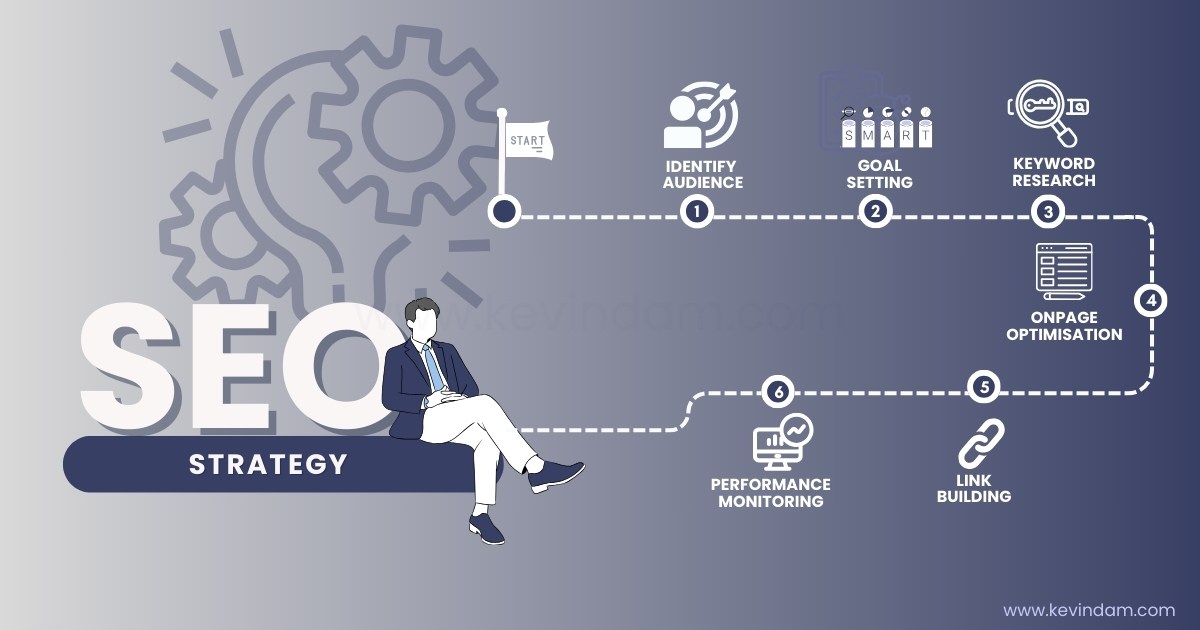
Last Updated August 14, 2024
Ultimate Guide to SEO Strategy: Tips, Tools, and Implementation Techniques
This article serves as a comprehensive guide to developing a successful SEO strategy, emphasising the essential elements of audience understanding, competitive analysis, and effective content optimisation. As you navigate through the practices in SEO, from keyword research to link building, you will learn how to tailor your approach to meet the specific needs and behaviours of your target audience.
By employing strategic tools and methods, such as Google Analytics, SEMrush, and Ahrefs, this guide offers actionable insights that will help you enhance your online visibility, outperform your competitors, and achieve measurable success in your digital marketing efforts.
Whether you’re refining existing tactics or starting from scratch, this article provides the roadmaps and tools necessary for crafting an effective SEO strategy.
Creating an Effective SEO Strategy
Creating a robust SEO strategy involves understanding the needs and interests of your target audience.
It is important to get inside their minds and know what they’re looking for when they type in those search queries. I often use tools like Google Suggest, Semrush, or Ahrefs to generate a list of relevant keywords and phrases that are likely to be used by potential visitors. Long-tail keywords are particularly beneficial as they tend to be less competitive but easier to rank for, thereby driving more targeted traffic to your website.
Once you have gathered a solid list of keywords, it’s time to take a closer look at the top-ranking websites for those keywords. By analysing the content and features of these top-ranking pages, you can identify patterns and types of content that rank well. This information can guide you on how to structure and optimise your own content effectively.
It’s also crucial to thoroughly analyse your main organic competitors using tools like Semrush or Ahrefs. This lets you gain insights into their common keywords, traffic levels, and overall strategy.
Understanding what is working for your competitors can provide valuable guidance in shaping your own approach.
Along with understanding your audience and competitors, high-quality content creation remains a cornerstone of any successful SEO strategy.
Transitioning from the strategic analysis stage, we now shift our focus to understanding the importance of identifying your targeted audience and goals in the world of SEO.
Identify Your Targeted Audience and Goals
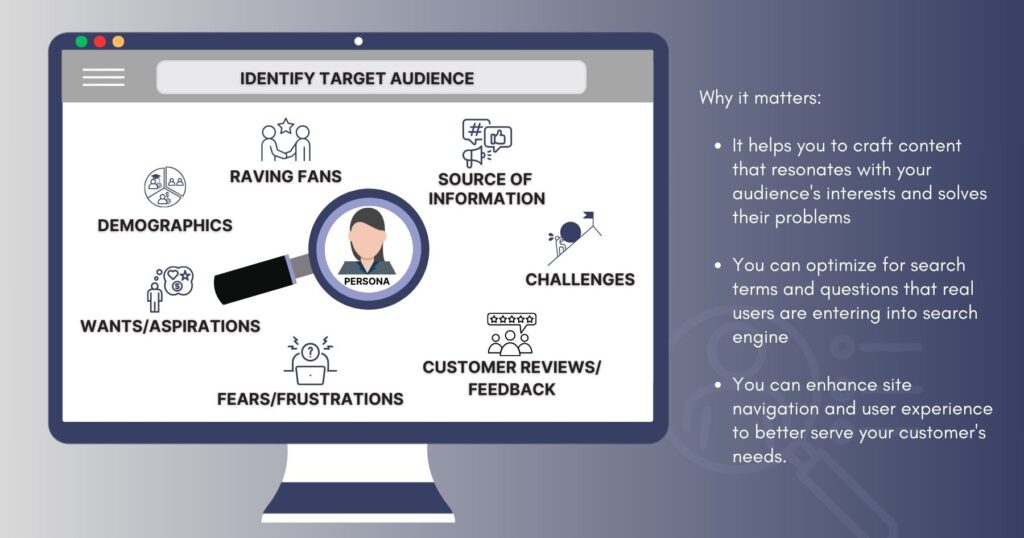
In the world of Search Engine Optimization (SEO), it is crucial to understand your audience and establish clear goals to craft a roadmap for success. You need to have a genuine understanding of your target audience, including their demographics, behaviours, interests, and pain points. This detailed insight into your audience will help you tailor your content to their needs, enhance its value and relevance, and ultimately increase your chances of success.
Understanding the demographics of your audience involves gathering details such as age, gender, location, profession, and income level. This data will guide the type of content you create, enabling you to address their specific needs and challenges.
For example, if a significant portion of your audience is young professionals in urban areas, you can focus on creating content that directly addresses their interests and concerns.
Analysing the online behaviour of your audience, on the other hand, includes understanding which platforms they use, how they search for information, and the type of content that resonates with them the most. By studying their preferences and behaviour, you can optimise your SEO strategy to ensure maximum visibility where your audience is most active.
For instance, if your research shows that a large portion of your audience engages with visual content on platforms like Instagram or Pinterest, this information can guide your content creation strategy. You might prioritise creating visually appealing infographics, or engaging videos optimised for those platforms.
Goal Setting
Establishing clear and measurable objectives is a foundational aspect of any successful SEO strategy. Whether your aim is to increase website traffic, improve lead generation, boost sales, or enhance brand visibility, well-defined goals provide direction and act as benchmarks for measuring the effectiveness of your efforts.
For instance, if one of your primary goals is to increase website traffic, you might set a specific target, such as achieving a 20% increase in organic traffic within six months. Similarly, if improving lead generation is a priority, establishing a measurable goal, like increasing the number of email sign-ups by 30%, can guide your SEO tactics.
Measurable objectives help you evaluate the impact of your SEO strategies over time. By tracking key performance indicators (KPIs) aligned with your goals—such as click-through rates, conversion rates, or keyword rankings—you can gain valuable insights into the effectiveness of your SEO efforts.
For example, if one of your goals is to boost sales through organic search, regular monitoring of KPIs related to conversion rates and revenue from organic traffic can provide actionable data to refine your SEO approach. This iterative process allows you to continually optimise your strategy to meet and exceed your objectives.
In the following section, we’ll explore how these insights inform the creation and optimisation of high-quality content tailored to resonate with your target audience and drive organic traffic to your website.
Tools for Audience Insight Gathering
Understanding your audience is critical in creating an effective SEO strategy. Fortunately, many powerful tools are available that can provide valuable insights into the behaviour, preferences, and demographics of your audience. Let’s explore some of these popular tools and how they can aid in crafting a targeted SEO strategy.
1. Google Analytics
Google Analytics is a robust platform that provides comprehensive data on website traffic, user behaviour, and engagement.
By leveraging this tool, you can gain valuable insights into the demographics of your audience, including their age, gender, location, and interests.
It offers detailed information on user behaviour, such as how users navigate your site, which pages they visit most frequently, and how long they spend on each page. This data is invaluable for refining your content strategy and optimising your website to better cater to the needs and preferences of your audience.
2. SEMrush
SEMrush is another indispensable tool for gaining audience insights and conducting competitive analysis.
It offers robust features for keyword research, backlink analysis, and social media monitoring, allowing you to gain a deeper understanding of your audience’s search behaviour and content consumption patterns.
SEMrush provides detailed analytics on organic and paid search traffic, enabling you to identify valuable opportunities for improving your SEO strategy and outperforming competitors in your niche.
3. Ahrefs
Ahrefs specialises in comprehensive backlink analysis and competitive research, making it an essential tool for understanding your audience’s digital footprint and online behaviours.
By examining the backlink profiles of competing websites and industry leaders, you can uncover valuable insights into content engagement, link-building strategies, and authoritative sources within your niche. This information empowers you to refine your SEO strategy by identifying untapped opportunities for building high-quality backlinks and enhancing your website’s authority in the eyes of both users and search engines.
Incorporating these tools into your SEO strategy equips you with actionable data that can inform every aspect of your digital marketing efforts. From content creation to outreach campaigns and website optimisation, audience insights gathered through these tools serve as the foundation for crafting targeted and effective SEO initiatives.
Crafting Targeted Website Content

Crafting targeted website content involves more than creating informative text—it’s about ingraining your brand’s voice and providing solutions to the problems and queries of your audience.
When done right, this content doesn’t just attract visitors; it keeps them engaged and coming back for more.
Relevance is Key: Your website content should revolve around the interests and concerns of your audience. It should be tailored in a way that resonates with their requirements, preferences, and behaviour.
Content relevance can be achieved through comprehensive keyword research to understand what users are searching for and incorporating these keywords naturally into your content.
Engagement through Solutions: Addressing user queries and dilemmas within your content can substantially enhance engagement.
When your content offers valuable insights and solutions, it becomes a go-to resource for users seeking answers. As a result, they spend more time on your website, increasing the likelihood of conversion.
For example, if you run an SEO consultancy firm like ours, your audience might be searching for tips on optimising their websites for better search engine rankings. By creating in-depth guides, blog posts, or videos that offer actionable advice in line with their current SEO challenges, you’re establishing yourself as an authoritative source they trust.
Picture crafting targeted website content as organising a delightful feast—each prepared dish represents a solution-driven piece of content that satisfies the appetite for knowledge within your audience.
To abide by today’s SEO best practices, weaving relevant keywords naturally into your content is vital.
However, it’s essential to avoid stuffing your articles with keywords as this jeopardises the reader’s experience and risks triggering search engine penalties. Balancing keyword inclusion with compelling and valuable content is key.
Think of keywords as seasoning on a dish—they should enhance the flavour without overpowering the taste.
Creating targeted website content requires an intricate blend of relevance, engagement through solutions, and natural keyword integration. Ultimately, it’s about offering high-value insights and initiating meaningful conversations with your audience.
Key Phrases Identification with Keyword Research
Keyword research is similar to searching for hidden treasures in the vast sea of the internet. It involves discovering those valuable words or phrases that people are actively searching for. These valuable keywords can help you create compelling content that grabs attention and drives traffic to your website.
Let’s begin by delving into the available keyword research tools. Google Keyword Planner, Semrush, and Ubersuggest are just a few options from various tools.
These tools provide valuable insights into keyword volume, competition, and related keywords that can help fine-tune your content strategy. Remember that each tool offers unique features and varying levels of depth, so it’s best to compare keywords within a single tool rather than across platforms.
For instance, Google Keyword Planner supplies detailed search volume data directly from Google, while Semrush offers a wide range of tools and is renowned for user intent analysis. On the other hand, Ubersuggest is known for its simple yet effective keyword suggestions and content ideas.
Selecting the right tool hinges on specific needs such as budget, data depth, and user interface.
Imagine you’re an antique shop owner in Seattle seeking to draw visitors to your website. You might wish to target specific keywords like “antique stores Seattle” or “vintage shops near me.” This is where keyword research shines.
Leveraging these tools, you can discover not only these primary keywords but also related terms such as “rare collectables,” “vintage furniture,” or “antique jewellery,” enabling you to craft comprehensive content around these topics.
Essential Features for Keyword Research Tools
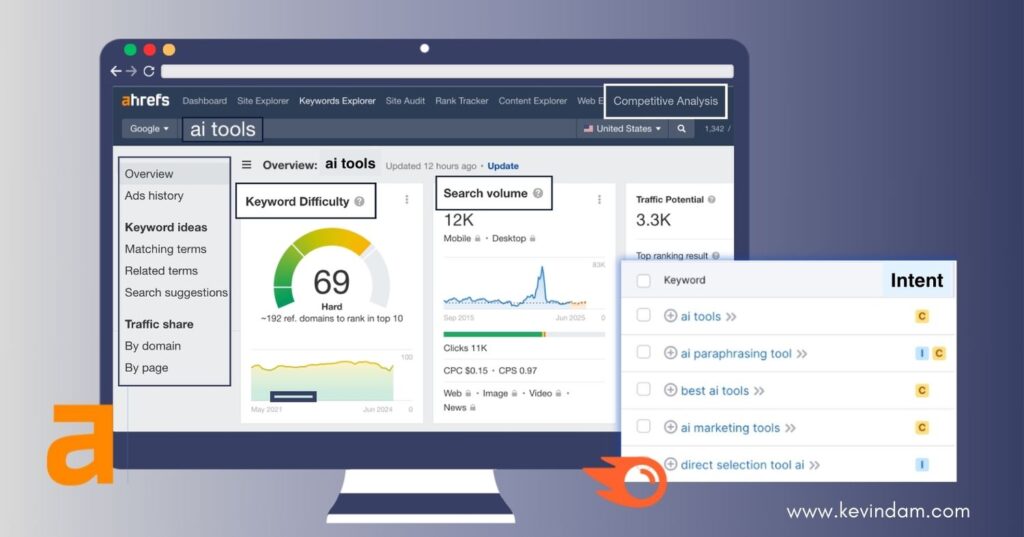
When considering which keyword research tool suits your needs, it’s imperative to look for features such as:
- Keyword Suggestions: Access a wide range of keyword ideas from various sources.
- Search Volume: Detailed information on how often a keyword is searched for in a given timeframe.
- Keyword Difficulty: An estimate of how hard it is to rank for a specific keyword.
- Search Intent Analysis: Insights into the reasons behind user searches and what they’re looking for.
- Competitor Analysis: Understanding what keywords competitors are targeting.
- Website Authority: Metrics that measure the strength and credibility of your website.
With this understanding, you’ll be poised to decide which keywords to target and how to strategically incorporate them into your content.
On-Page Optimisation Tactics Implementation
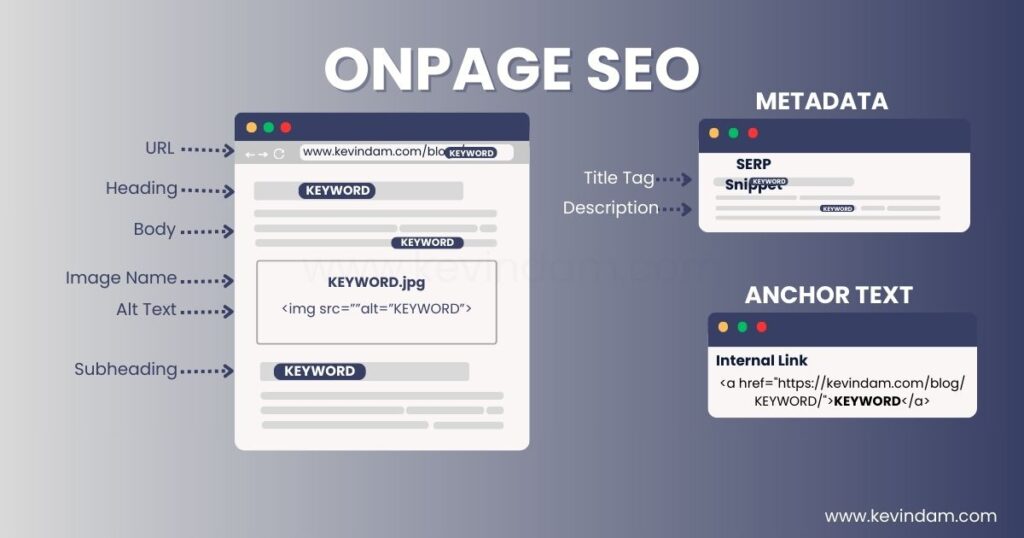
Implementing on-page SEO techniques is a crucial aspect of improving your website’s visibility in search engine results. Let’s explore some effective techniques to optimize your web pages in a powerful way.
Meta Tags
Meta tags are significant in providing search engines with information about your webpage. This is vital for helping search engines understand what your content is about.
When implementing meta tags, ensure the title accurately reflects the content of the page and includes relevant keywords. Craft compelling meta descriptions that provide a concise summary of the page content, enticing users to click through from the search results.
| Meta Tag | Purpose |
| Title Tag | Provides a clear and accurate title for the webpage |
| Meta Description | Summarises the content of the page and encourages click-through |
Internal Linking
Internal linking is a powerful tool for optimising your website’s SEO. It helps guide users to relevant content within your site and assists search engines in crawling your website more effectively.
Use descriptive anchor text that includes relevant keywords to provide context for the linked page. Ensure that the linked pages are related and provide additional value to the user’s current experience.
Comprehensive Link Building Plan
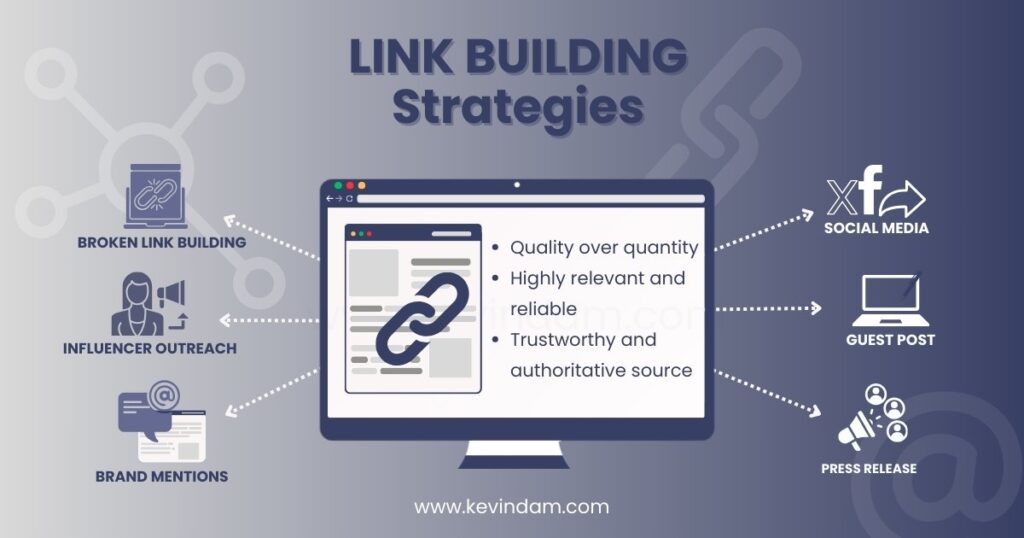
Link building is the process of acquiring hyperlinks from other websites to our own. These links not only bring direct traffic but also have a significant impact on search visibility and domain authority.
This comprehensive strategy involves deliberate actions aimed at improving our website’s reputation, relevance, and trustworthiness through the acquisition of quality backlinks from reputable websites.
Identify beneficial backlinks. Creating a robust link-building plan is to identify the types of backlinks that are beneficial for our specific industry and target audience. This involves researching websites that are authoritative and relevant to our niche, such as reputable marketing and technology-related websites if we specialise in providing SEO services. Identifying these authoritative sources is crucial for gaining backlinks that positively impact our search engine rankings and brand authority.
Identify methods to acquire backlinks. Consider tactics that will help us acquire these high-quality backlinks.
- Guest posting can be an effective method where you contribute valuable content to other websites in exchange for a backlink.
- Influencer outreach is another valuable strategy, utilising endorsements from influential figures in your industry to secure backlinks from their followers.
- Promote your content through various channels to attract attention and earn organic backlinks.
Ensure high-quality backlinks. Making sure that the acquired backlinks come from reputable and authoritative websites within your industry is crucial. Quality over quantity is the guiding principle here. One highly relevant and reliable backlink can significantly outweigh multiple low-quality backlinks from irrelevant sources. It’s all about establishing a strong link profile that reflects expertise, authority, and trust in the eyes of search engines.
In addition to guest posting, influencer outreach, and content promotion, explore other link-building strategies such as broken link building, unlinked mentions, and strategic content partnerships (co-marketing). Each technique aims to secure valuable backlinks that elevate our website’s visibility and credibility while adhering to ethical and sustainable practices within the digital ecosystem.
As you develop comprehensive link-building plan with a focus on high-quality backlink acquisition, it’s important to remember that an effective strategy requires ongoing assessment and refinement. Pursuing reputable backlinks is not a one-time effort but an evolving process that contributes to our long-term success in the competitive landscape of search engine rankings and digital visibility.
Competitor Analysis and Link Opportunities
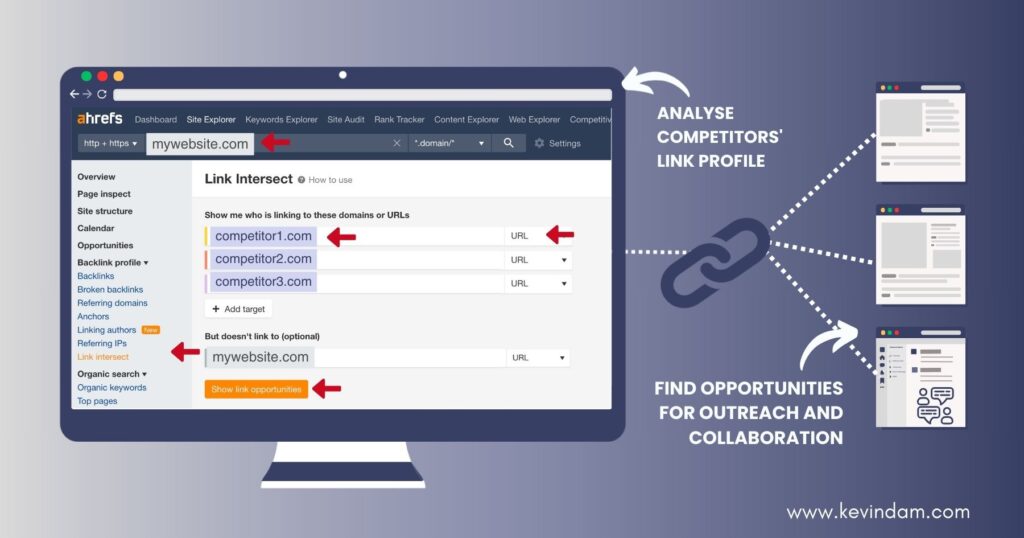
When it comes to SEO strategy, keeping an eye on your competitors’ activities can offer valuable insights. One of the most effective ways to build high-quality backlinks is by analysing your competitors’ link profiles. By doing so, you can uncover potential link opportunities that they have tapped into but you may have missed.
Tools like Ahrefs and SEMrush provide in-depth competitor link analysis. They allow you to see which websites are linking to your competitors but not to your site. This presents an opportunity for outreach and collaboration with these websites to secure valuable backlinks for your own site.
Finding relevant, authoritative websites that are linking to your competitors can guide your outreach efforts in securing valuable backlinks for your own site. A tailored and personalised outreach strategy often yields better results when engaging potential linking partners.
Here’s a practical scenario: Let’s say you run a blog about organic gardening. Through competitor analysis, you discover that a popular gardening website has linked to several of your competitors’ articles but not yours. This presents a prime opportunity for outreach. You could reach out to the website, offering them valuable content or resources in exchange for linking to your blog as well.
Just as you would seek out new connections in your industry for collaboration and mutual benefit, identifying potential link opportunities through competitor analysis can expand your website’s network and authority within the digital landscape.
Incorporating competitor analysis and identifying link opportunities into your SEO strategy can provide a strategic advantage in building a strong and authoritative backlink profile for your website. It’s an indispensable aspect of any comprehensive SEO approach aimed at improving search engine visibility and attracting relevant traffic to your site.
Adopting Budget-Friendly Marketing Strategies
Investing in search engine optimisation doesn’t have to break the bank. With some savvy techniques, you can improve your website’s visibility and attract organic traffic without hefty financial investments. Let’s explore some cost-effective SEO strategies that can make a big impact without draining your budget.
Content Marketing
Content marketing involves creating and sharing valuable, relevant content to attract and engage your target audience.
This can be achieved through blog posts, articles, infographics, videos, and more. By consistently producing high-quality content that resonates with your audience, you can drive organic traffic to your website and improve your search engine rankings.
The aim is to provide educational and valuable insights that visitors find helpful, which in turn increases the chances of them linking back to your content.
ACTIONABLE TIP: Regularly update your blog or resources section with informative articles that address common questions or pain points within your industry. This not only enhances your site’s authority but also provides fresh content for search engines to index.
Social Media Promotion
Social media is an effective platform for promoting your brand and driving traffic to your website. You can increase brand visibility and attract new visitors by actively engaging with your audience on social channels and sharing valuable content.
Leveraging hashtags, running contests or giveaways, and collaborating with influencers are just a few examples of how social media promotion can enhance your SEO efforts at a low cost.
ACTIONABLE TIP: Encourage social sharing by integrating social media buttons on your website for easy content sharing. This helps amplify your reach and drives traffic back to your site.
Email Outreach
Email outreach is a powerful tool for building relationships with other websites in your niche and acquiring valuable backlinks. By reaching out to relevant websites and offering them compelling content or collaboration opportunities, you can secure backlinks that boost your website’s authority and visibility in search results.
Additionally, sending newsletters or announcements to your subscribers keeps them engaged with your brand, driving repeat visits and increasing user interaction signals that search engines value.
ACTIONABLE TIP: Craft personalised outreach emails that demonstrate the value you can offer to potential collaborators or partners. Building genuine relationships goes a long way in securing quality backlinks.
By incorporating these budget-friendly marketing strategies into your SEO approach, you can create a strong foundation for improving website visibility and attracting organic traffic. These tactics not only help elevate your online presence but also contribute to long-term sustainable growth for your business.
With these SEO strategiest, it’s time to focus on measuring our efforts’ success and examining the impact on our search engine rankings.
Measuring SEO Success and Ranking Increases
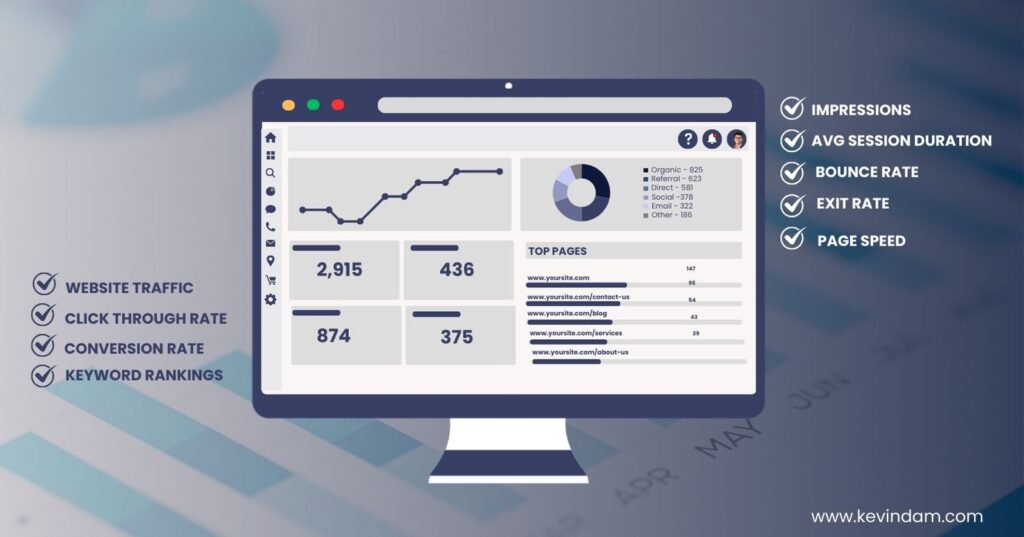
When it comes to search engine optimisation, measuring success is all about data. We need to carefully track and analyse several key performance indicators (KPIs) to truly understand the effectiveness of our SEO strategy.
Website Traffic
First, let’s talk about website traffic. This is one of the most essential KPIs you’ll be monitoring. Tools like Google Analytics can provide detailed insights into your website traffic, including how many people are visiting your site, which pages they’re landing on, and how long they’re staying. By understanding these metrics, you can gauge the impact of your SEO strategy on driving organic traffic to your site.
Suppose you notice a significant increase in organic traffic after implementing your SEO strategy. In that case, it suggests that your content is ranking well and attracting more visitors from search engines. Conversely, if there’s no improvement or a decline, it may indicate that adjustments are needed in your approach.
Keyword Rankings
Ranking for relevant keywords is a primary goal of any SEO strategy. Tools like Google Search Console can help you monitor keyword rankings and identify trends over time. By regularly tracking these rankings, you can gain valuable insights into whether your content is rising in the search results or losing visibility.
User Engagement
User engagement is another critical aspect of SEO success. This includes metrics such as bounce rate, average session duration, and pages per session. Google Analytics provides detailed user engagement data that can help you understand how users are interacting with your site.
For instance, a high bounce rate might indicate that visitors are not finding the information they’re looking for, while a low average session duration may suggest that users are quickly leaving your site. By analysing these metrics, you can identify areas for improvement and refine your content to better meet user needs.
The ability to measure success and track ranking improvements in real-time is fundamental in ensuring that your SEO strategy remains effective and aligned with your business goals. Utilising tools like Google Analytics and Search Console will provide valuable data-driven insights that can inform strategic decisions and optimisations.
Conclusion
Developing a successful SEO strategy requires a deep understanding of your target audience, a keen eye on your competitors, and the effective implementation of content and technical SEO practices. Integrating tools like Google Analytics, SEMrush, and Ahrefs helps you gather actionable insights that refine your approach and enhance your online presence.
Regularly setting measurable goals and adjusting your strategies based on performance metrics are crucial for maintaining and improving your search engine rankings. Embrace these strategies to meet and exceed your digital marketing objectives, continually adapting to changes and updates.
